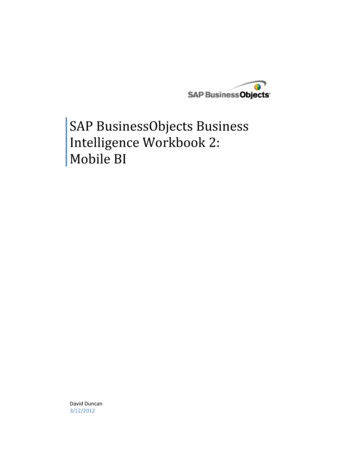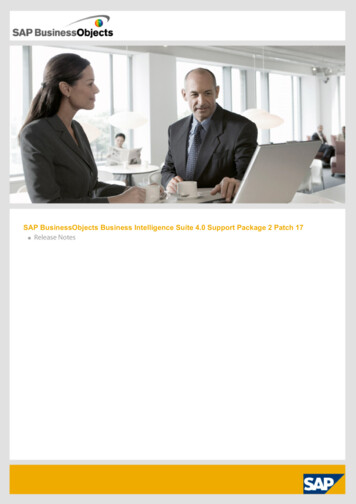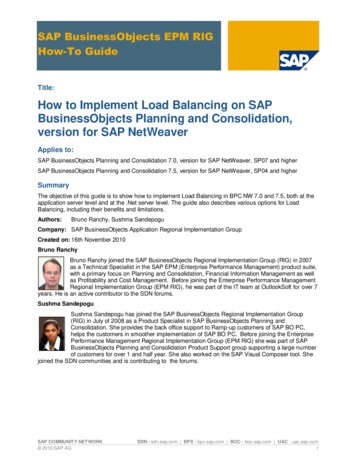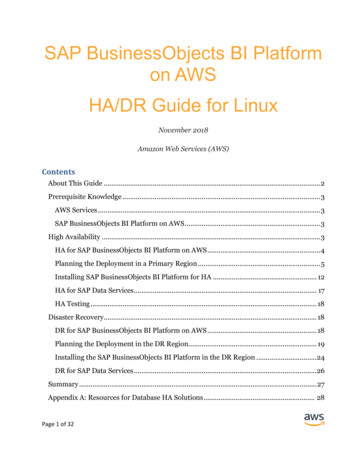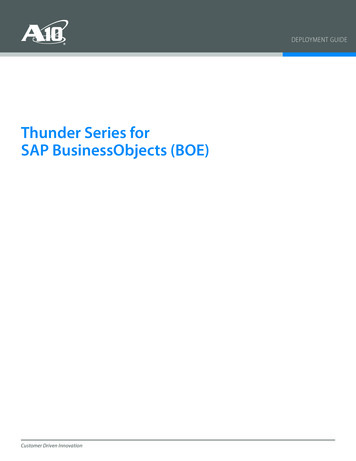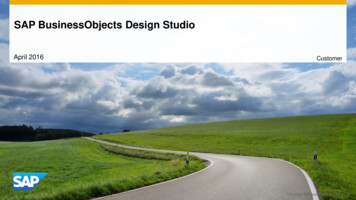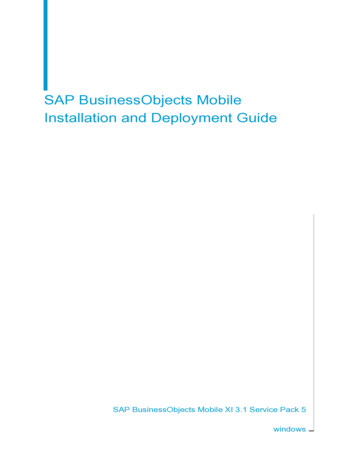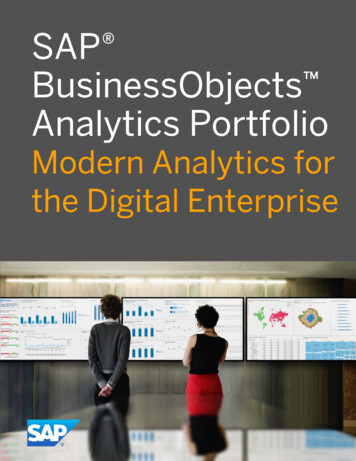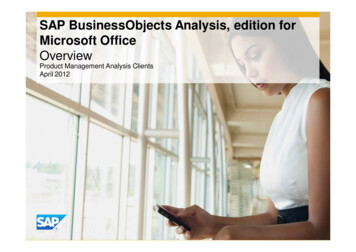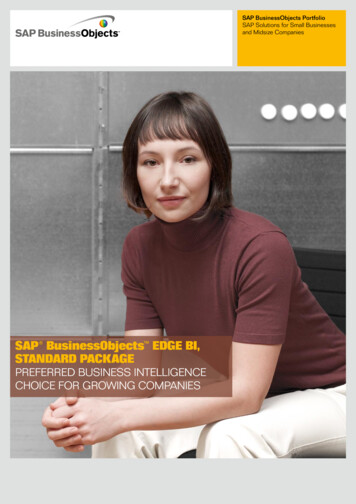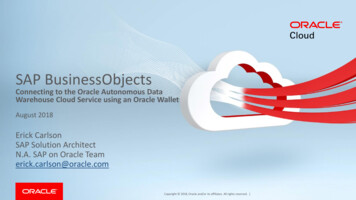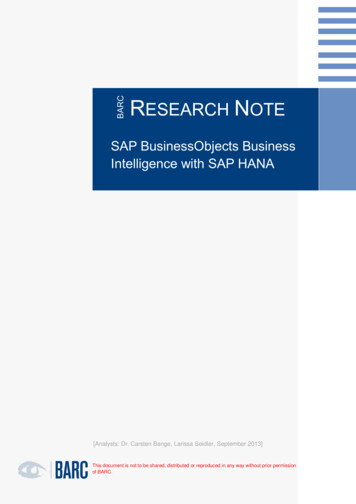
Transcription
BARCRESEARCH NOTESAP BusinessObjects BusinessIntelligence with SAP HANA[Analysts: Dr. Carsten Bange, Larissa Seidler, September 2013]This document is not to be shared, distributed or reproduced in any way without prior permissionof BARC.
Table of ContentsExecutive Summary .2SAP BusinessObjects Overview .3Overview of SAP BusinessObjects.3How the BusinessObjects product portfolio is developing .3SAP BusinessObjects Business Intelligence with SAP HANASAP HANA overview .4Integrating data within HANA .4HANA interfaces to retrieve and write back data.5How HANA is developing .7Providing Business Intelligence with HANA .7The BI perspective: Selecting the right approach for different implementations of BI withBusinessObjects and HANA .7Functional BI use cases .7BI deployment view.8The HANA perspective: Providing BI in different HANA deployment scenarios .9HANA used as a stand-alone data mart .9BW powered by HANA. 10HANA used as an application platform (for the Business Suite and other applications) . 10Step-by-step guidelines on how to define a roadmap for BusinessObjects BI with HANA . 12BARC-Whitepaper – SAP BusinessObjects Business Intelligence with SAP HANAPage 1
Executive SummaryEven though it was only introduced in 2011, SAP’s HANA in-memory database and computingplatform is already playing a central role in the company’s product portfolio and strategy. In thisbriefing we analyse how HANA and SAP’s BusinessObjects suite of business intelligence productswork together for improved decision making in organizations.SAP BusinessObjects Business Intelligence with SAP HANAHANA is optimised for both transactional and analytical processing so enabling real-time analytics andapplications. Its columnar structure, massively parallel processing functionality, and the way it storesdata in main memory means it can process large amounts of data very quickly.This leads to very fast response times for query and analysis. Existing BI tools and applications - butalso new web-based and mobile analytical applications - can benefit from this capability.SAP’s broad offering of BI tools and applications provided in the “BI 4.1” suite is evolving to reflect thechanging requirements now demanded by reporting, dashboarding and analysis applications. Suchdevelopments - supporting flexibility and independence of business users for Self Service BI (SSBI),visual analysis, predictive analysis or mobile devices for distributing and accessing BI content andtools - are benefiting from a high performance platform. One might say such developments couldn’t beprovided in a meaningful way without one.BI tools and applications, such as BusinessObjects, interact with HANA in different ways. Whilst datain tables are accessed by standard SQL requests, more advanced platform features can be used withExtended SQL, SAP’s own SQL extension. Applications, for example those developed in HTML5, canalso use oDATA middleware to interact with the HANA application server (called XS Engine).How BI is provided through BusinessObjects and HANA differs according to user functionality and howBI is being deployed in the company.SAP’s tools for reporting, dashboarding, analysis and planning can all access HANA, but in technicallydifferent ways. The Self Service BI product SAP Lumira is an example of how SAP is taking its firststeps towards tighter integration between HANA and BusinessObjects BI tools. Lumira can publish auser’s models and views to HANA to make them available to other users.As well as this Self Service BI deployment scenario the combination of HANA and BusinessObjectsbecomes very interesting for operational BI. Support for this data from a SAP ERP system can bereplicated by a HANA platform to make its high calculation and query performance available for timeintensive tasks and analytical applications.Taking this further is the use of HANA as a database and computing platform for the SAP BusinessSuite. This powerful in-memory platform can supply operational data in real-time with views andinformation models providing the flexibility with which to define different views on the data. Additionallya package of pre-defined content and models called SAP HANA Live can speed up theimplementation of operational BI especially with the Business Suite running on HANA.For SAP customers the combination of BusinessObjects and HANA opens up many interesting newcapabilities. For example, a new target architecture and tool landscape can now be defined to fit acompany’s BI strategy much more accurately. A roadmap considering business, organisational andtechnical implications of the new technologies can elevate an organisation to a new level of businessintelligence.BARC-Whitepaper – SAP BusinessObjects Business Intelligence with SAP HANAPage 2
SAP BusinessObjects OverviewFor more than 10 years SAP’s BI technology has been providing relevant decision-making informationto a broad range of users. Its first solution - SAP NetWeaver Business Warehouse (BW) – was apackaged business intelligence solution designed to complement SAP ERP applications. BWintegrates and processes transactional data and delivers it to front-end tools for display and analysis.SAP BusinessObjects Business Intelligence with SAP HANAIn 2008, SAP acquired BusinessObjects. The acquisition brought SAP a bevvy of best-of-breed BItools and applications. These front-end technologies replace the SAP Business Explorer (BEx) BI toolswith a strategic tool suite that is continuously being developed (Table 1).In 2011, two milestones followed: SAP launched its first major release following the acquisition ofBusinessObjects – the SAP BusinessObjects BI 4.0 suite and, secondly, the company introduced anew in-memory platform - SAP HANA - optimised for both transactional and analytical processing soenabling real-time analytics and applications.HANA’s columnar structure, its massive parallel processing functionality, and the way it stores data inmain memory means it can process large amounts of data very quickly. This leads to very fastresponse times for query and analysis. But HANA is not just a database. It’s also a platform suited tonew web-based and mobile analytical applications. The company’s Self Service BI product SAPLumira is an example of how SAP is taking its first steps towards tighter integration between HANAand BusinessObjects BI tools.Overview of SAP BusinessObjectsSAP offers reporting, dashboarding and analysis tools in a BI suite for all categories and user roles(Table 1). Its central point of integration is a BI platform that supports tools administration - fromassigning user rights to system configuration and performance optimisation. The BI Launchpad portalalso provides a central publication platform for BI content and a central point of access for most toolswhich form part of the suite.Table 1: Key BI front ends from SAPProduct categoryKey productsDashboardingSAP BusinessObjects Design Studio (Design Studio)Formatted ReportingSAP Crystal ReportsAd-hoc ReportingSAP BusinessObjects Web Intelligence (WebIntelligence)Analysis (multidimensional)SAP BusinessObjects Analysis (Analysis)Analysis (free, explorative)SAP Lumira (former SAP Visual Intelligence)Analysis (advanced, statistical)SAP Predictive AnalysisHow the BusinessObjects product portfolio is developingFor many years - first with BW and later through its BusinessObjects acquisition - SAP has deliveredBI software which satisfies the typical requirements of processing, visualising and analysing data (coreBI functionality). But these requirements have changed dramatically over the last few years.Now users want to interact with their business systems in the same way they do with their personalapplications and devices – user-friendly, web-based applications and intuitive-to-use mobile devicesBARC-Whitepaper – SAP BusinessObjects Business Intelligence with SAP HANAPage 3
which deliver data back to the user quickly and in a form, usually straightforwardly and visually, that iseasy-to-understand and can be acted upon in seconds.One of the biggest resulting trends in business intelligence is increasing the flexibility andindependence of business users for Self Service BI (SSBI). Requirements in this category aremanifold and range from creating reports independently (ad hoc) to local data integration andmodelling. If BI tools are to be accepted by the business user community then it is important that SSBIis user friendly and offers intuitive functionality.SAP BusinessObjects Business Intelligence with SAP HANAVisualising information is an important factor in usability – especially if you need to analyse large,possibly fast changing and poly-structured data sources effectively (Big Data Analysis). Visuallyappealing and meaningful charts, tables and diagrams help users understand complex issues.Improved support for visual analyses has been introduced in Lumira (formerly SAP Visual Intelligence)- the first in a new line of Self Service BI tools introduced by SAP. Lumira increases independence andflexibility for an end user, e.g. through sophisticated data integration functionality and HANAoptimisation. Support for advanced analyses such as predictive analysis and data mining can be foundin Predictive Analysis.Using mobile devices for distributing and accessing BI content and tools is also becoming very popular(mobile BI). The main objectives for this kind of functionality are to deliver current and relevantinformation and bring BI generally closer to the user. Information access becomes ubiquitous withmobile BI, enabling a decision maker to react promptly and independently from his/her currentwhereabouts. Now with the new product Design Studio, part of the BI 4.1 suite, you can startdesigning mobile applications which make the most of this kind of functionality.SAP HANA overviewSAP HANA is both a database and a data platform that leverages in-memory data processing as itscore technology. It is designed to process large volumes of data in real-time and can source data fromvirtually any data source using standard data integration technology.HANA is available as an appliance (pre-installed software on pre-configured hardware from SAP’scertified hardware partners) to be used on premise/in-house or as a cloud solution provided by SAP.HANA is used for both transactional and analytical processing. Using in-memory technology andcombining a row- with a column-oriented database structure the platform can speed up processing inoperational applications – such as ERP and CRM solutions - but it can also provide reporting,dashboarding and analysis capabilities with data in real-time directly from the transactional system.Here the reporting and analysis of data required in operational processes doesn’t have to betransferred out of the transactional system, e.g. into a data warehouse. HANA provides one integrateddata foundation for running real-time applications and providing operational BI with application data.If data transformation is necessary - e.g. grouping it for analysis purposes - the necessary calculationscan be performed ‘on the fly’ in HANA since the database provides the necessary performance.Integrating data within HANATypically, there are two ways to support decision making: Operational Business Intelligence supportsdecision making in processes, e.g. with a list report or a dashboard that helps to monitor specificprocesses and usually only shows data from a single process or a single transactional system. Thereis also a need for supporting tactical and strategic decision making with data warehouses that areinvaluable for integrating data from multiple sources or transforming data in more complex ways.HANA supports both approaches in its three major deployment scenarios:BARC-Whitepaper – SAP BusinessObjects Business Intelligence with SAP HANAPage 4
SAP BusinessObjects Business Intelligence with SAP HANA1)acting as a database for the Business Suite, HANA can address decision support so reportsand analyses can run directly on the operational data;2)it can also act as an additional database to existing systems that take in data and provide itto BI tools and applications;3)or as a database for BW, the data warehouse management system from SAP that canmanage a data warehouse data model instantiated in HANA.Depending upon how it’s used, HANA is able to accommodate both real-time data integration(replication/synchronisation) or the batch oriented extraction, transformation and loading of data (ETL).These two and other possible approaches to data integration are provided with additional tools - suchas SAP Landscape Transformation Replication Server (SLT) - for replicating data in real-time. SAPData Integrator (part of SAP Data Services) extracts and transforms data from many possible systemsand loads it into HANA.As a modelling tool SAP HANA Studio can be used to set up and control the tables that store the datain a HANA database. ‘Information Models’ provide views on to this data. Views can be set up flexibly sothat data can be supplied to users in a way that helps them to understand it.Figure 1: HANA overview: From source system data to business intelligence applications.HANA interfaces to retrieve and write back dataOn the one hand, HANA is a row and column-oriented relational database that can be accessed usingseveral data interfaces. On the other, HANA operates as an application server (XS engine) which canbe used to support web-based applications (e.g. HTML5).There are three ways of interacting with HANA:BARC-Whitepaper – SAP BusinessObjects Business Intelligence with SAP HANAPage 5
SAP BusinessObjects Business Intelligence with SAP HANA1)HANA provides physical data tables stored in-memory. These tables can be accessed withtools and applications. To extract and write back data from and to the HANA databaseseveral HANA data interfaces can be used. Standard ANSI/ISO SQL is supported byHANA.2)Views on tables and more comprehensive ‘information models’ (a collection of views andHANA artefacts such as variables and hierarchies) can be accessed using “Extended SQL”,the HANA SQL dialect.3)As an application server XS Engine can be accessed via oData, HTTP or by other means.All of the interfaces internally trigger the various HANA engines in different ways. Developers of clienttools can decide which interface provides the best option for leveraging HANA’s client architecture andhow deep their interaction with the data in HANA has to be.Figure 2: HANA layers and interfacesHANA’s three interfaces are based on open standards: SQL, MDX and oData. They make sure clienttools can work with HANA models in a relational manner, in a multi-dimensional representation and in aformat which is suited for HTTP or HTML5 based requests. Currently, the MDX interface is not widelyused or supported. The SQL interface provides extensions for SAP BI client tools which can make fulluse of the HANA information models (HANA information models can contain much more functionalitythan a typical relational object which cannot be expressed in plain SQL). Currently Crystal Reports,Web Intelligence, Lumira and Predictive Analysis use SQL Extensions to access HANA functions andspecifics such as parameters, variables, or units of measures.HANA also provides you with a way of interacting with data in-memory using lower level function calls such as the Computation Engine (CE) functions, and other languages such as the R statistics andpredictive programming language. Such calls to lower level functions can be embedded in a scriptinglanguage. SAP’s BI Consumer Services (BICS) technology is used to consume CE functions with SAPBI clients such as Analysis and Design Studio. Predictive algorithms in Predictive Analysis can leveragethe R language in HANA. Detailed information on the integration of SAP BI tools with SAP HANA canbe found in the paper “Connecting BI4.0 Client Tools to SAP HANA” available on the SAP CommunityNetwork.BARC-Whitepaper – SAP BusinessObjects Business Intelligence with SAP HANAPage 6
Non-SAP client tools can access HANA data using the ODBC/JDBC middleware and SQL as alanguage. Certification for several BI tool vendors is on the way, but we recommend to test any use ofa non-SAP tool with HANA in a proof of concept.SAP BusinessObjects Business Intelligence with SAP HANAHow HANA is developingEven though it was only introduced in 2011, HANA is already playing a central role in SAP’s productportfolio and strategy. After introducing HANA in “side-by-side” scenarios where data is replicated fromthe SAP ERP system to the database for faster calculation and analysis, it is now being offered as adatabase for BW and Business Suite applications. In addition, HANA is available for those companieswithout any SAP application and who are looking for a data mart solution to address the need for realtime insight into their business.As this relatively young technology matures development efforts are becoming focused on supportingmore and more processes and applications. Also integrating semi-structured data, such as textdocuments is a new feature to broaden the possibilities to use HANA in Big Data scenarios. Also byusing the new near-line storage option for BW on HANA that uses a SAP Sybase IQ database forstoring data on disk that is not very frequently accessed means you can cut costs, making sureexpensive computer memory is used just for priority applications with other data stored on lessexpensive disk drives.Another important development is being able to use HANA’s performance to speed up processes inSAP applications. The latest BW release benefits from faster data load processes when running onHANA. This solves the problem we hear about so regularly – that data load times exceed the timelimits that are available for them. Executing calculation-intensive tasks can also be performedsignificantly faster when the ERP system is running on HANA, opening up operational processes. Thisporting of application logic in to the HANA system will take place over many years but early examplesof this being done are showing that the technology has enormous potential.Providing Business Intelligence with HANAThe HANA analytical database can be used in many Busin
also new web-based and mobile analytical applications - can benefit from this capability. SAP’s broad offering of BI tools and applications provided in the “BI 4.1” suite is evolving to reflect the changing requirements now demanded b
